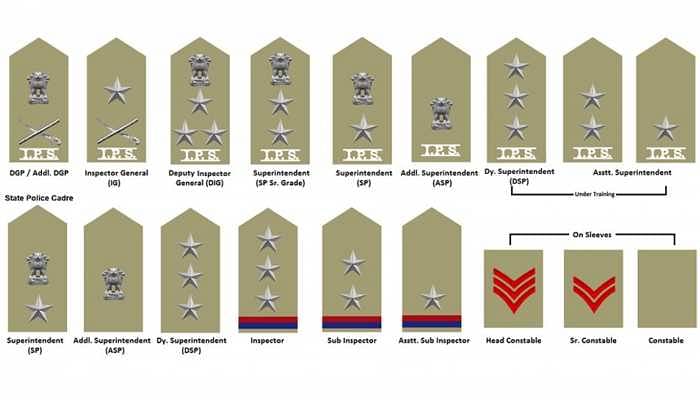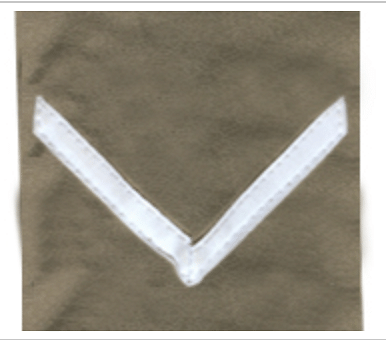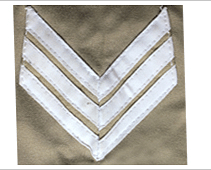Police Ranks in India: Check Rank List PDF, Police Posts with Badges, Stars & Salary
The police ranks in India comprise Constable, Head Constable, Assistant Sub-Inspector, Sub-Inspector and so on. Find out the highest police rank in India while we take you through the complete police rank list, police posts, badges, stars and more.
Police ranks in India, in order of hierarchy, start with DGP and end with Constable. In each state of India, the government is responsible for appointing police officers and also for appointing the powers that apply to the police ranks in their respective states. The state government defines the Indian police ranks by the legislatures and the rules. However, in the union territories, the Central government is responsible for controlling the police post list and salary through lieutenant governors of the union territories. The union government also has the power to establish any particular order regarding the police rank list in India if there is an emergency. Read on to learn about the police rank list in India/police position list and the different Indian police ranks.
Also Read: How to Become a Police Officer?
Levels for Police Ranks in India
The Indian Police recruits candidates at four different levels for its ranks. Each level has its own set of eligibility criteria, training requirements, and responsibilities within the force. The police post list is as follows:
- Constabulary
- Upper Sub-ordinate
- SPS (through the State Public Service Commission)
- IPS ( through Union Public Service Commission)

Order wise Police Rank List in India with Insignia & Stars
The Indian government follows a specific hierarchy when it comes to recruiting police ranks. This hierarchy involves various ranks of police and badges, which signify the authority and responsibilities of the officers. Below is a table displaying the rank wise Indian police ranks and their corresponding badges.
Ranking | Police Rank (Lowest to Highest) | Stars on Uniform | Badge | Recruitment Method |
15 | Constable | No Star | Direct Recruitment through the Police Recruitment Board | |
14 | Lance Naik/ Havaldar | No Star - Single Strip |  | Direct Recruitment through the Police Recruitment Board |
13 | Havaldar/ Senior Constable | No Star - Three Strips | Promotion | |
12 | Head Constable/Assistant Sub-Inspector (ASI) | One Star, One Red Strip and One Blue Strip | Promotion/ Direct Recruitment through the Police Recruitment Board | |
11 | Sub-Inspector (SI) | Two Star, One Red Strip and One Blue Strip | Promotion | |
10 | Inspector | Three Star | Promotion | |
9 | Deputy Superintendant of Police (Dy. SP) | Three Star, One Red Strip and One Blue Strip | PPS recruited through the SPSC/IPS in the initial years | |
8 | Assistant Superintendent of Police (ASP) | Three Star & IPS Badge | IPS/PPS through promotion | |
7 | Additional Superintendent of Police (ASP) | Ashok Emblem & IPS Badge | IPS/PPS through promotion | |
6 | Superintendent of Police (SP) | Ashok Emblem, One Star & IPS Badge | IPS/PPS through promotion | |
5 | Senior Superintendent of Police (SSP) | Ashok Emblem, Two Star & IPS Badge | IPS through promotion | |
4 | Deputy Inspector General of Police (DIG) | Ashok Emblem, Three Star & IPS Badge | IPS through promotion | |
3 | Inspector-General of Police (IG) | One Star, Cross Swords & IPS Badge | IPS through promotion | |
2 | Additional Director General of Police (ADG) | Ashok Emblem, Cross Swords & IPS Badge | IPS through promotion | |
1 | Director-General of Police (DGP) | Ashok Emblem, Cross Swords & IPS Badge | IPS through promotion | |
| Download Police Rank List in India PDF | ||||
All Police Ranks in India in Detail
The Indian Police Service ranks are structured in a hierarchy that mirrors the organization of the police force in India. This hierarchy is designed to establish a clear chain of command and authority. The organization of police ranks in India is as follows:
Constable Rank in Indian Police
The rank of Constable is the starting position in the police rank list in India. In some states, constables are referred to as 'Sipahi.' Upon recruitment, they are allowed to carry rifles, with arms training provided after recruitment. As they gain experience, a constable can advance to become a senior constable and then be promoted to the rank of head constable. This progression offers three main posts of police:
Constable
Senior Constable
Head Constable
Assistant Sub Inspector Rank in Indian Police Department
Assistant sub-inspectors are recruited through competitive examinations conducted by state governments for different police post ranking. Each state in India has its own recruitment process and competitive examinations for various positions within the police force. There are three main positions of police available within this rank:
Assistant Sub-Inspector of Police (ASI)
Sub-Inspector of Police (SI)
Inspector of Police (PI)
Provincial/State Police Service Officers (PPS/SPS) Ranks
The State Public Service Commission has a crucial role in recruiting state police service officers, officially recognized as a gazette service. Those who have served in this position for a long time may be eligible for promotion to the Indian Police Service. After appointment as a Deputy Superintendent of Police (DSP) by their state Public Service Commission, individuals may be assigned to one of four main positions.
Deputy Superintendent of Police (DSP)
Additional Superintendent of Police (ASP)
Superintendent of Police (SP)
Senior Superintendent of Police (SSP)
Police Ranks in India: IPS
To join the Indian Police Service (IPS), you must first pass a specific civil service examination. Once you pass this exam, you will be eligible to be appointed as an assistant superintendent post in police department. Following your success in the civil services examination, you will have the opportunity to consider different roles within the police position list.
Assistant Superintendent of Police
Additional Superintendent of Police
Superintendent of Police (SP)
Senior Superintendent of Police (SSP)
Deputy Inspector General of Police
Inspector-General of Police (IGP)
Additional Director General of Police
- Director-General of Police (DGP)
Police Post List with Salary
The table below contains the complete list of police ranks in India, along with their respective monthly salaries.
Police Ranks in India | Average Salary |
Inspector General of Police (IG) | INR 17.50 LPA |
Director General of Police (DGP) | INR 14.30 LPA |
Senior Superintendent of Police (SSP) | INR 13.50 LPA |
Superintendent of Police (SP) | INR 10.60 LPA |
Additional Superintendent of Police (ASP) | INR 9 LPA |
Deputy Superintendent of Police (DSP) | INR 7 LPA |
Inspector | INR 6.50 LPA |
Sub-inspector | INR 5.30 LPA |
Head Constable | INR 4.20 LPA |
Constable | INR 3- 4 LPA |
Also Read: How to Prepare for IAS After 12th Board Exams
Police Rank List in Commissionerate System of Policing
In India, the police departments have two separate chains of command. On a daily basis, the departments operate under the authority of the Superintendent of Police. However, the executive powers of the police department reside with the District Magistrate, who is responsible for maintaining law and order in a specific city or district. This means that the District Magistrate must issue any warrants required by the police. However, due to the District Magistrate's numerous other responsibilities, this system often delays obtaining warrants and arms licenses.
To address this issue, some states have reorganized their police forces in metropolitan areas and other important cities or districts into commissionerate systems. Under this system, the police commissioner, who holds the rank of Deputy Inspector General (DIG), also possesses executive authority to issue warrants. This reorganization aims to streamline the process and expedite law enforcement procedures in these areas.
Police Rank in IG and Commissionerate System of Policing
There are some differences in the Police department ranks in the IG and Commissionerate system of policing. While the lower ranks in both systems are the same, differences in ranks arise at the level above the inspector rank due to more powers in the Commissionerate system. Check the police hierarchy in the commissionerate system from the table given below.
Police Rank in IG Police System | Police Rank in Commissionarate Police System |
Director-General of Police (DGP) | |
Additional Director General of Police (ADG) | Commissioner of Police |
Inspector-General of Police (IGP) | Additional Commissioner of Police |
Deputy Inspector General of Police | Additional Commissioner of Police |
Senior Superintendent of Police | Deputy Commissioner of Police |
Superintendent of Police | Additional Deputy Commissioner of Police |
Additional Superintendent of Police | Additional Deputy Commissioner of Police |
Deputy Superintendant of Police (Dy. SP) | Assistant Commissioner of Police |
Inspector | |
Sub-Inspector | |
Assistant Sub-Inspector | |
Head Constable | |
Constable | |
Also Read: How to Prepare for UPSC Civil Services Personality Test
What is the Highest Police Rank in India?
In the Indian police force, the highest position is that of the Director-General of Police (DGP). The DGP occasionally reports directly to the chief minister of the state and, in other cases, to the Chief Secretary of the state. The Indian Police Service (IPS) is one of the three All India Services (AIS), and individuals are selected for this prestigious service by the Union Public Service Commission (UPSC) and allocated to individual state governments. At the highest level of a state's policing framework is the IPS. Only IPS members become eligible for leadership positions in the police force, making it a critical and influential role. If you need more details on the highest police rank in India, go through the points below.
The cabinet appoints the DGP, and they hold a 3 star police rank.
Other officers from the Indian police rank list may also hold the rank of DGP in the state.
The rank insignia of a Director General of Police or Commissioner of Police (in Delhi) is the national emblem over crossed sword and baton.
These officers wear Gorget patches on their collars. The patches have a dark blue background with an oak leaf pattern stitched on it.
The state government appoints them in consultation with the UPSC.
Also Read: Best Graduation Subjects for IAS after 12th
2 Star Police Ranks In India
A Sub-Inspector (SI) is designated by two stars, signifying a mid-level rank in the police force. On the other hand, a Head Constable is identified by a single star on their shoulder, denoting a lower rank compared to a Sub-Inspector. Moving up the hierarchy, the Senior Superintendent of Police (SSP), a senior position in the Indian Police Service and state police services, is distinguished by two stars, indicating high authority and leadership. It's important to note that the SSP rank is higher than that of a Superintendent of Police (SP) but lower than that of a Deputy Inspector General of Police (DIG).
3 Star Police Ranks in India
Inspectors and higher ranks are assigned three stars, while the Ashok Emblem replaces the stars for even higher ranks. Swords are used to denote the highest levels of hierarchy. The Deputy Inspector General of Police (DIG), a senior-ranking officer, is identified by three stars on the shoulder board and is responsible for leading the police force in a state or union territory. Their duties include overseeing law enforcement activities, maintaining public order, and ensuring the safety and security of citizens within their jurisdiction. In the State Police Services, the rank of Deputy Superintendent of Police (DSP) is indicated by three stars.
The structure of police ranks in India is meticulously organized to ensure a clear hierarchy and chain of command within the law enforcement system. Understanding this hierarchy and the path of progression within the Indian police force not only clarifies the organizational structure of law enforcement in India but also highlights the opportunities and challenges faced by those serving to maintain law and order in the country.
Related Links:
Stay tuned with us for more articles and information related to police post rank wise and recruitment in India!
Get Help From Our Expert Counsellors
FAQs
Is there a 1 star police rank in India?
Yes, the Assistant Sub-Inspector (ASI) rank in the Indian police service is indicated by a single star on their uniform, and is senior to Head Constables. The Superintendent of Police (SP) and Inspector-General of Police (IG) also have a single star on their uniform but are much senior than the Assistant Sub-Inspector (ASI) rank.
What are the police ranks in order?
The police ranks in order of highest authority/seniority are as follows:
- Director-General of Police (DGP)
- Additional Director General of Police (ADG
- Inspector-General of Police (IG)
- Deputy Inspector General of Police (DIG)
- Senior Superintendent of Police (SSP)
- Superintendent of Police (SP)
- Additional Superintendent of Police (ASP)
- Assistant Superintendent of Police (ASP)
- Deputy Superintendant of Police (Dy. SP)
- Inspector
- Sub-Inspector (SI)
- Head Constable/Assistant Sub-Inspector (ASI)
- Havaldar/ Senior Constable
- Lance Naik/ Havaldar
- Constable
Is there any 4 star police rank in India?
No, there is no 4-star police rank in India. The highest rank in the Indian Police Service (IPS) is Director General of Police (DGP), which is a 3-star rank. The DGP occasionally reports directly to the chief minister of the state and, in other cases, to the Chief Secretary of the state.
What are the Indian police ranks and salary?
The Indian police ranks and salary have been mentioned below:
- Inspector General of Police (IG): INR 17.50 LPA
- Director General of Police (DGP): INR 14.30 LPA
- Senior Superintendent of Police (SSP): INR 13.50 LPA
- Superintendent of Police (SP): INR 10.60 LPA
- Additional Superintendent of Police (ASP): INR 9 LPA
- Deputy Superintendent of Police (DSP): INR 7 LPA
- Inspector: INR 6.50 LPA
- Sub-inspector: INR 5.30 LPA
- Head Constable: INR 4.20 LPA
- Constable: INR 3- 4 LPA
What is the police all post list?
The police all post list include each and every police rank in India. As per the list, the lowest to highest police ranks in India are Constable, Lance Naik/ Havaldar, Havaldar/ Senior Constable, Head Constable/Assistant Sub-Inspector (ASI), Sub-Inspector (SI), Inspector, Deputy Superintendant of Police (Dy. SP), Assistant Superintendent of Police (ASP), Additional Superintendent of Police (ASP), Superintendent of Police (SP), Senior Superintendent of Police (SSP), Deputy Inspector General of Police (DIG), Inspector-General of Police (IG), Additional Director General of Police (ADG), and Director-General of Police (DGP).
Does the Central Government release a police promotion list?
No, the Central Government of India does not release a police promotion list. Promotion for every rank in the police rank list in India happens through a proper system and is done based on a candidate’s experience and time served in the Indian police force. Each rank on the police post list has its own set of eligibility criteria, training requirements, and responsibilities within the force.
Which is the highest post in the police rank list?
The highest post in the police rank list is that of the Director-General of Police (DGP). The DGP occasionally reports directly to the chief minister of the state and, in other cases, to the Chief Secretary of the state. Other senior post in the police rank list include Additional Director General of Police (ADG), Inspector-General of Police (IG), Deputy Inspector General of Police (DIG), etc.
Who is responsible for the police post list in India?
The state government of India defines the police post list in India by the legislatures and the rules. However, in the union territories, the Central government is responsible for controlling the police post list and salary through lieutenant governors of the union territories. The union government also has the power to establish any particular order regarding the police rank list in India if there is an emergency.
Which is higher on the police post list in India, IG or DGP?
The Director General of Police (DGP) is higher in rank than an Inspector General of Police (IG) in the Indian police hierarchy. The DGP is typically the head of the police force of an entire state or union territory, while an IG is responsible for overseeing policing operations in a specific range of districts or zones within the state.
Who is a 2 star police officer in India?
The Director General of Police (DGP) has the highest salary as per the other police ranks in India. The average salary of the DGP stands at INR 2,25,000 per month. The Additional Director General of Police (ADGP) makes INR 2,05,400 per month and the Inspector General of Police (IGP) makes INR 1,44,200 per month.





